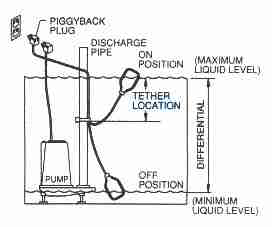Other pumps use floats that are on arms which will raise and lower with the water level.
Tethered float switch problems.
As the water rises the float rises causing the tether to flip the switch and turn on the pump.
Most systems need to be adjusted at least one time to get the float at the perfect level.
A pedestal pump will generally have a bulb style float attached to a metal rod which activates the motor s switch.
Different types of sump pumps use different types of floats.
Once the cover is off and located and you ve identified the switch a tether switch is easy to test.
The float rises with the rising water level and throws a switch that kicks the pump on.
Float switch failure a vertical action float is attached to a rod that floats above the water.
Once the water level drops the float drops loosening the tether releasing the switch and shutting off the pump.
Make sure the tether is not getting tangled with any other cords or the side of the basin.
In order to test a tether switch simply grab hold of the float and position it so the wire side is facing down.
The creator of this video believes the failures are due to the.
Diaphragm switches are generally the.
A tethered float is one that is attached to the pump using a tethering device.
If the switch is not working the float might be functioning flawlessly but you will still not have a working.
A tethered float is used primarily for pedestal pumps.
The float rises with the water and turns on.
If the float switch is still not at the right level detach the power and readjust.
As water level decreases to a certain level the switch then turns the pump off.
When the float rises it is supposed to trigger a switch that tells your pump to turn on.
A tether float switch features a float tethered to the pump and is more common with sewage pumps or larger basins.
Activation switch problems the float is just one part of a very important mechanism that controls your sump pump.

